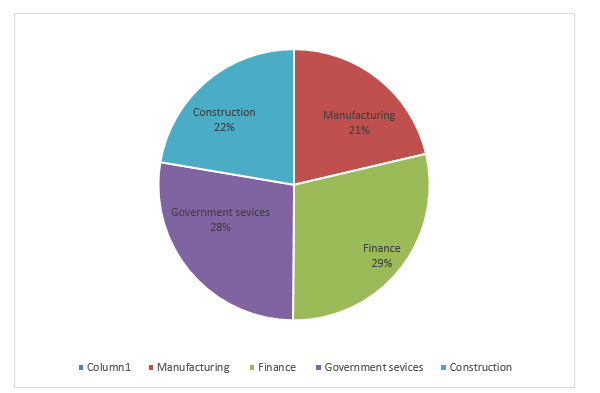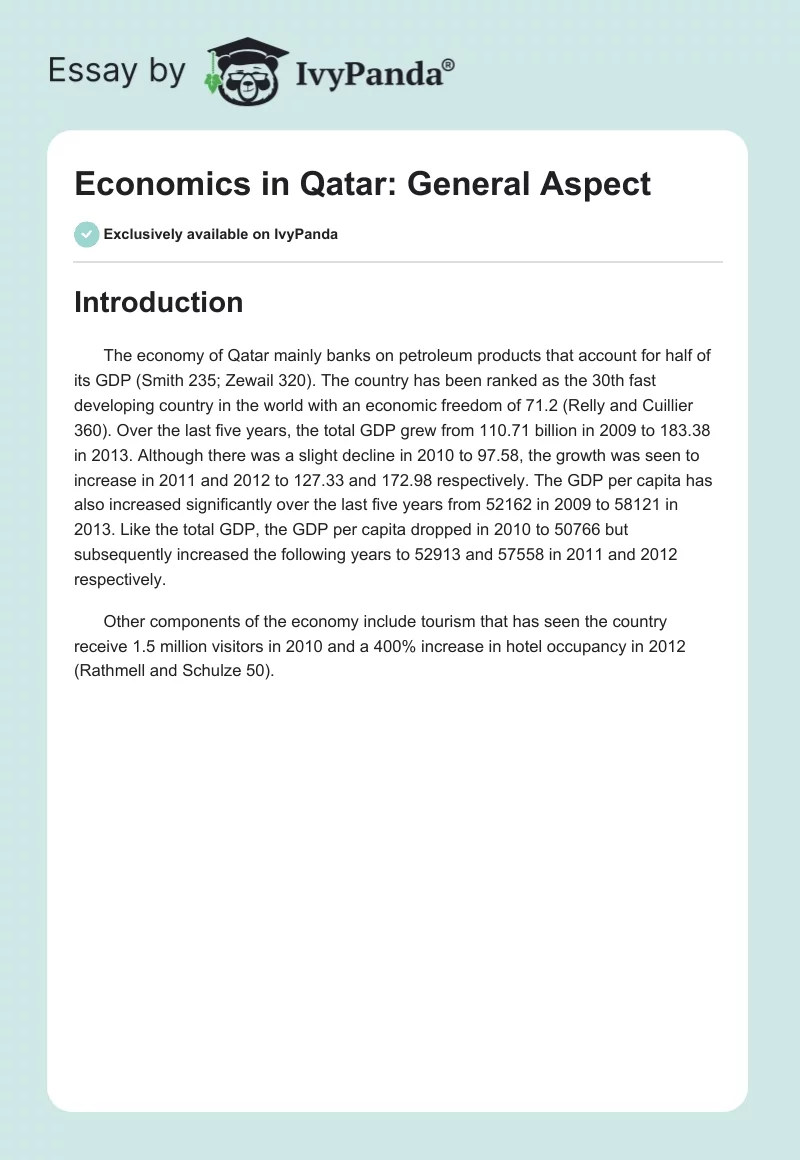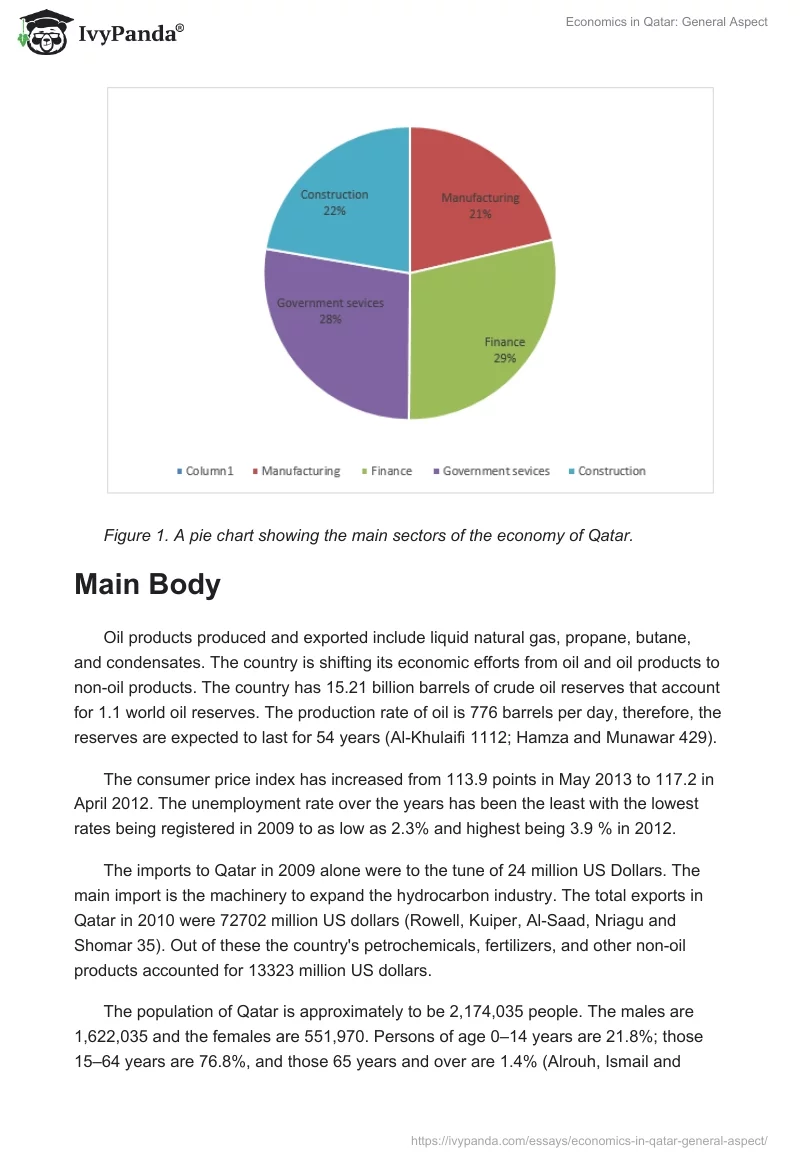Introduction
The economy of Qatar mainly banks on petroleum products that account for half of its GDP (Smith 235; Zewail 320). The country has been ranked as the 30th fast developing country in the world with an economic freedom of 71.2 (Relly and Cuillier 360). Over the last five years, the total GDP grew from 110.71 billion in 2009 to 183.38 in 2013. Although there was a slight decline in 2010 to 97.58, the growth was seen to increase in 2011 and 2012 to 127.33 and 172.98 respectively. The GDP per capita has also increased significantly over the last five years from 52162 in 2009 to 58121 in 2013. Like the total GDP, the GDP per capita dropped in 2010 to 50766 but subsequently increased the following years to 52913 and 57558 in 2011 and 2012 respectively.
Other components of the economy include tourism that has seen the country receive 1.5 million visitors in 2010 and a 400% increase in hotel occupancy in 2012 (Rathmell and Schulze 50).

Main Body
Oil products produced and exported include liquid natural gas, propane, butane, and condensates. The country is shifting its economic efforts from oil and oil products to non-oil products. The country has 15.21 billion barrels of crude oil reserves that account for 1.1 world oil reserves. The production rate of oil is 776 barrels per day, therefore, the reserves are expected to last for 54 years (Al-Khulaifi 1112; Hamza and Munawar 429).
The consumer price index has increased from 113.9 points in May 2013 to 117.2 in April 2012. The unemployment rate over the years has been the least with the lowest rates being registered in 2009 to as low as 2.3% and highest being 3.9 % in 2012.
The imports to Qatar in 2009 alone were to the tune of 24 million US Dollars. The main import is the machinery to expand the hydrocarbon industry. The total exports in Qatar in 2010 were 72702 million US dollars (Rowell, Kuiper, Al-Saad, Nriagu and Shomar 35). Out of these the country’s petrochemicals, fertilizers, and other non-oil products accounted for 13323 million US dollars.
The population of Qatar is approximately to be 2,174,035 people. The males are 1,622,035 and the females are 551,970. Persons of age 0–14 years are 21.8%; those 15–64 years are 76.8%, and those 65 years and over are 1.4% (Alrouh, Ismail and Cheema 209). Other nationalities include persons from South Asia, Egypt Jordan, Somalia, and Iran (Krichene 557; Williams, Bhanugopan and Fish 200).
The government is avid leadership on economics. Some state-owned companies such as Qatar Petroleum export most hydrocarbon and non-hydrocarbon products. The government controls education through the ministry of education and the Supreme Education Council.
Conclusion
Qatar is a fast-growing country whose economy mainly relies on oil. The population is 2.17 million people where males were three times more than the women. The country’s GDP was 183 million US dollars in 2013. The country engages in the import and export of goods. Its main export is oil. Other exports include butane, liquid natural gas, propane, and petrochemical. The main imports are machines and metals to enlarge the hydrocarbon industry. The countries that are in trades with are the US, Japan, China Italy, and Germany. The country’s oil reserves are set to be depleted in 54 years, and the main economic pillar will be unavailable. The country needs to consider embarking on industrialization and the automobile industry to sustain its economy in the future.
Works Cited
Al-Khulaifi, Abdulla S. “Exports and Imports in Qatar: Evidence from Cointegration and Error Correction Model.” Asian Economic and Financial Review 3.9 (2013): 1122-1133. Print.
Alrouh, Hekmat, Awatef Ismail, and Sohaila Cheema. “Demographic and health indicators in Gulf Cooperation Council nations with an emphasis on Qatar.” Journal of Local and Global Health Perspectives 10.3 (2013): 202-210. Print.
Hamza, Waleed, and Mohiuddin Munawar. “Protecting and managing the Arabian Gulf: Past, present and future.” Aquatic Ecosystem Health & Management 12.4 (2009): 429-439. Print.
Krichene, Noureddine. “World crude oil and natural gas: a demand and supply model.” Energy Economics 24.6 (2002): 557-576. Print.
Rathmell, Andrew, and Kirsten Schulze. “Political reform in the Gulf: The case of Qatar.” Middle Eastern Studies 36.4 (2000): 47-62. Print.
Relly, Jeannine E., and David Cuillier. “A comparison of political, cultural, and economic indicators of access to information in Arab and non-Arab states.” Government Information Quarterly 27.4 (2010): 360-370. Print.
Rowell, Candace, Nora Kuiper, Khalid Al-Saad, Jerome Nriagu, and Basem Shomar. “A market basket survey of As, Zn and Se in rice imports in Qatar: Health implications.” Food and Chemical Toxicology 70 (2014): 33-39. Print.
Smith, Benjamin. “Oil wealth and regime survival in the developing world, 1960–1999.” American Journal of Political Science 48.2 (2004): 232-246. Print.
Williams, Justin, Ramudu Bhanugopan, and Alan Fish. “Localization of human resources in the State of Qatar: Emerging issues and research agenda.” Education, Business and Society: Contemporary Middle Eastern Issues 4.3 (2011): 193-206. Print.
Zewail, Ahmed H. “Dire need for a Middle Eastern science spring.” Nature materials 13.4 (2014): 318-320. Print.


